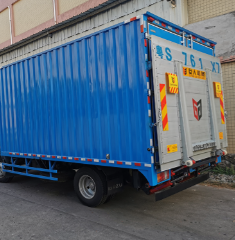
Checking the oil level on the tailboard of a car is one of the important steps to maintain its normal operation. The following are detailed inspection steps and precautions:
1、 Preparation before inspection
Parking position: Park the vehicle on a flat and level surface to ensure the accuracy of oil level measurement.
Safety preparation: Ensure that the vehicle is turned off and the handbrake is tightened to prevent accidents during the inspection process.
2、 Inspection steps
Find the hydraulic oil tank: First, you need to locate the hydraulic oil tank on the car's tailboard. The hydraulic oil tank is usually located near the power unit of the tailboard, but the specific location may vary depending on the vehicle model.

Observing the hydraulic oil gauge: There is usually a glass scale or oil level gauge next to the hydraulic oil tank, used to observe the oil level of the hydraulic oil. This scale will be marked with the lowest and highest oil level lines.
If the hydraulic oil tank does not have a glass scale, other tools (such as an oil level gauge) may need to be used to check the oil level. At this point, one should refer to the vehicle's user manual or consult professional maintenance personnel.
Read the oil level:
For hydraulic oil tanks with glass scales, simply observe the oil level on the scale. Ensure that the oil level is between the lowest and highest oil level lines.
If an oil level gauge is used, it needs to be inserted into the hydraulic oil tank and then pulled out to observe the height of the oil film and the condition of the oil.
Checking oil quality: While checking the oil level, attention should also be paid to observing the color and texture of the hydraulic oil. If the hydraulic oil is found to be turbid, odorous, or contain impurities, it should be replaced in a timely manner.
3、 Precautions
Regular inspection: It is recommended to check the oil level of the tailboard at least once a week to ensure that the oil level remains within the normal range.
Timely replenishment: If the oil level is found to be below the minimum oil level line, hydraulic oil should be replenished in a timely manner. When supplementing, use hydraulic oil that meets the requirements and follow the correct filling method.
Professional maintenance: If you are not familiar with the oil level inspection or hydraulic oil replacement of the tailboard, it is recommended to seek the help of professional maintenance personnel to ensure correct operation.
In summary, checking the oil level on the tailboard of a car is an important step in maintaining its normal operation. By following the above steps and precautions, it is possible to ensure that the hydraulic oil level of the tailboard remains within the normal range, thereby extending the service life of the tailboard and improving its working efficiency.

Professional to provide security
for modern logistics
A new company that efficiently handles
and unloads equipment
Please do not hesitate to contact us
0769-81251088

Add friend consultation